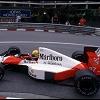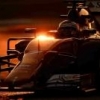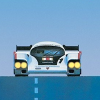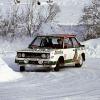
Cars from which era were the easiest to drive?
#1

Posted 08 July 2012 - 09:37
Advertisement
#2

Posted 08 July 2012 - 09:40
#3

Posted 08 July 2012 - 09:43
We've all heard how hard to drive were the beasts from the 50's and 60's. But which era had cars which were the easiest to drive? Was it maybe in the early 90's with the active suspension or the early 2000s with advaced traction control? Discuss!
Every era had its challenges. Perhaps the cars of the early 60s were not as difficult as others due to the relative lack of power ?
#4

Posted 08 July 2012 - 09:45
#5

Posted 08 July 2012 - 09:47
Depends what you mean by easy. Back in the 50s and 60s the drivers weren't subjected to the same forces that they are now. They had a lot to do and had to concentrate but you could see that they didn't need the fitness levels needed nowadays. I'd imagine that the best cars from those days were also beautifully balanced machines which would respond very well to the drivers inputs.
Even in the early 90s days of active suspension and auto gearboxes and traction control, the cars were fairly crude compared to today. They needed looking after quite a lot too.
#6

Posted 08 July 2012 - 09:50
#7

Posted 08 July 2012 - 09:55
#8

Posted 08 July 2012 - 10:24
Let's say that if there is a "standard difficulty" - 100%
Car 1 will be able to go 1.30.000 at that difficulty
Car 2 will be able to go 1.25.000 at that difficulty
Car 3 will be able to go 1.22.000 at that difficulty
You could say Car 1 is more difficult to drive than Car 3, but you could also say Car 3 is faster than Car 1
Edited by SirRacer, 08 July 2012 - 10:30.
#9

Posted 08 July 2012 - 10:38
#10

Posted 08 July 2012 - 11:18
#11

Posted 08 July 2012 - 11:23
I would say early 90s cars. Active Suspension, traction control, fully automated gearboxes when all that stuff was banned everyone struggled to adapt.
That's what I would also point to. It helped make 1994 the worst F1 season in history as it was littered with considerable accidents with the likes of Lamy/Alesi/Montermini/Wendinger/Lehto all missing races as a result.
#12

Posted 08 July 2012 - 11:26
That's what I would also point to. It helped make 1994 the worst F1 season in history as it was littered with considerable accidents with the likes of Lamy/Alesi/Montermini/Wendinger/Lehto all missing races as a result.
That doesn't necessarily mean that the 1993 cars were easy, more that the 1994 were very challenging.
#13

Posted 08 July 2012 - 11:30
I remember being at Spa in 98 and Martin Brundle drove Fangios Merc around the circuit.
He said it was really awkward to drive. He said the steering wheel was too big and heavy and he also said his feet were about 2 feet apart.
I don't know how I remember this as I was quite drunk at the time.
#14

Posted 08 July 2012 - 11:35
#15

Posted 14 October 2012 - 19:45
#16

Posted 14 October 2012 - 22:24
I imagine the current cars are the easiest to drive. They have low horsepower compared to cars of the past, but all the benefits to handling, stability, general predictability provided by the more advanced state of modern engineering.
This.. the only thing though is that they have to multi task more than ever.. in terms of KERS and DRS.. plus close qualifying.. competitive etc.. these aspects are maybe harder than they ever have before.
But driving an average lap in the race is VERY easy compared to how it used to be. The cars have the best handling and aero and are low on revs and power. Only other thing about modern cars is the 'cliff' that the tyres have. But on an average lap.. they are 'driving to a laptime' as someone else said.
#17

Posted 14 October 2012 - 22:31
This.. the only thing though is that they have to multi task more than ever.. in terms of KERS and DRS.. plus close qualifying.. competitive etc.. these aspects are maybe harder than they ever have before.
But driving an average lap in the race is VERY easy compared to how it used to be. The cars have the best handling and aero and are low on revs and power. Only other thing about modern cars is the 'cliff' that the tyres have. But on an average lap.. they are 'driving to a laptime' as someone else said.
They are easy in terms of having good grip, but it's a definite challenge to control the tires. Any wheelspin you get costs you seconds at the end of the stint.
#18

Posted 14 October 2012 - 22:38
#19

Posted 14 October 2012 - 22:40
I would say early 90s cars. Active Suspension, traction control, fully automated gearboxes when all that stuff was banned everyone struggled to adapt.
But the winners and strongest pilots were still the same from the turbo era through that early 90s phase until they retired. Only Schumacher joined and was quick to estabilish himself.
If they had been that easy to drive, newcomers would certainly have been much more competitive from the go.
Not to metion the Andretti experiment.
I think that barely having to push nowadays takes a lot of the tension off the drivers, but with KER and dozens of functions and controles to look after and use, it cant be easy, just less strenous.
Advertisement
#20

Posted 14 October 2012 - 22:44
Still there were challenges. Grooved dry weather tyres had ZERO tolerancy to the first drops, and while good cars nearly never slid, when they did you either lost a chunk of time or go off. Back then when someone had to make a correction he always would lost lots of time to cars around, now you see them doing it non stop.
#21

Posted 14 October 2012 - 22:52
#22

Posted 14 October 2012 - 23:43
I wonder how every driver today would do in a Benetton B192...
Edited by George Costanza, 14 October 2012 - 23:47.
#23

Posted 15 October 2012 - 00:01
#24

Posted 15 October 2012 - 00:27
None car is easy to drive near the limit, but less hard... It has to be early 2000's cars. You barely saw any corrections on the wheel -talking about front runners, bad cars on that era looked a total handful- and there was literally no need for throttle modulation.
Still there were challenges. Grooved dry weather tyres had ZERO tolerancy to the first drops, and while good cars nearly never slid, when they did you either lost a chunk of time or go off. Back then when someone had to make a correction he always would lost lots of time to cars around, now you see them doing it non stop.
Yeah, during the big arms race at about 2001-2004 the grip levels were ridiculous.
#25

Posted 15 October 2012 - 00:30
None car is easy to drive near the limit, but less hard... It has to be early 2000's cars. You barely saw any corrections on the wheel -talking about front runners, bad cars on that era looked a total handful- and there was literally no need for throttle modulation.
Still there were challenges. Grooved dry weather tyres had ZERO tolerancy to the first drops, and while good cars nearly never slid, when they did you either lost a chunk of time or go off. Back then when someone had to make a correction he always would lost lots of time to cars around, now you see them doing it non stop.
No corrections, huh? Then what the hell is this:
#26

Posted 15 October 2012 - 00:35
In terms of mental skill I think modern cars are the hardest to drive simply because you have to focus on so many things besides purely driving. In the turbos, your body would be knackered but mentally you'd be in less trouble.


#27

Posted 15 October 2012 - 05:24
I'll take the two extremes to illustrate my point. If you take a pre 68 car, for many technical reasons stability was weak compared to today and more so because low grip meant limit of traction was easily reached. The main task of the driver was to control the car and both by necessity and because they could do it for the far lower cornering speeds+track designs they could slide (i mean lose temporarily traction on 3 wheels) and control it.
If you take an actual F1 car (reading that an F1 car is "low HP" is amusing...750 hp for ICE + 80 HP kers is not something i would call "low hp" especially if you compare to pre 92 cars, except the 85-86 era the power/weight ratios were equal or lower than now) the grip levels are much higher and stability (because of wings and progresses in suspension dynamics) is much greater which is actually a necessity to higher cornering speeds. In addition gearboxes are much faster. This has led to completely different driving styles were you can't afford to lose stability because with the speeds involved you're out of the track (hence why you see much less corrections) so you need to approach the traction limit by the lower margin, never overdriving it while at the same time the technological progresses mean you need to be ultra agressive.
Have you seen the recent cornering technics? (i mean really from the day of seamless gearboxes) you approach the corner around 300km/h you have to brake 75 meters before, trail braking is a must, and downshift all the way to the reacceleration point! then you re-accelerate much faster than in the 67 cars. I think to get a good idea of what it takes one should try a good simulator (like netkar pro or iracing) and see what it takes to post real competitive lap times. As some F1 drivers said the main challenge for them is to exploit the car potential to the max
To me then the two era were very different in term of driving style skills but on the overall i think nowadays are much harder because the require finer inputs at higher speeds+ the physical demands though the bravery of former drivers is so impressive.
Note that i speak about qualifying paces.
Edited by Ogami musashi, 15 October 2012 - 05:25.
#28

Posted 15 October 2012 - 05:50
The turbo cars were bloody difficult to drive by all accounts. Plus a stick shift. Mentally challenging as you had to regulate absolutely every part of the corner not to muck it up.
#29

Posted 15 October 2012 - 06:59
2011 and 2012. With the Pirelli tires, the drivers aren't pushing at all, and everyone can drive to the required laptime. That's why spins and off track excursions are so rare.
This.
#30

Posted 15 October 2012 - 07:08
You couldn't be more wrong. 800BHP sends you into a spin in a flash. Some guy testing a Jag F1 2004 edition proved that.with traction control it takes skill away, driving fast without any help
#31

Posted 15 October 2012 - 07:47
#32

Posted 15 October 2012 - 10:16
It wasn't just some guy. Chris Harris tested one.You couldn't be more wrong. 800BHP sends you into a spin in a flash. Some guy testing a Jag F1 2004 edition proved that.
Link:
Does that look easy to you, to go fast AND maintain control?
#33

Posted 15 October 2012 - 10:23
To be fair, that was in Imola. The next race, in Spain, was the first at which driving aids such as traction control etc. were once again allowed. The cars were of course never absolutely stable, but I don't think it's inaccurate that there was less need for such quick corrections in the years 2001-2007.No corrections, huh? Then what the hell is this:
#34

Posted 15 October 2012 - 10:31
#35

Posted 15 October 2012 - 11:01
No F1 car has ever been easy to drive.
I disagree with you.
They are generally easy to drive, but battling against physics of G-forces, brake heat, grip of tyres, power og engine, smooth aerodynamics, selfcontrol of fear, guts.
It's like saying running is easy, it is. But getting times like Usain bolt, takes some effort, practise, practise and so on.
#36

Posted 15 October 2012 - 11:16
Regards Mike
#37

Posted 15 October 2012 - 11:16
Renault F1 demo straight line crashI disagree with you.
They are generally easy to drive, but battling against physics of G-forces, brake heat, grip of tyres, power og engine, smooth aerodynamics, selfcontrol of fear, guts.
It's like saying running is easy, it is. But getting times like Usain bolt, takes some effort, practise, practise and so on.
Edited by encircled, 15 October 2012 - 11:31.
#38

Posted 15 October 2012 - 11:28
He failed to adapt power of engine, grip of tyres. Though driver is experienced on other quick vehicles, he is rather newbie with F1 cars.
#39

Posted 15 October 2012 - 12:00
Advertisement
#40

Posted 15 October 2012 - 12:03
#41

Posted 15 October 2012 - 12:39
A 100cc kart is ultra simple to drive - just a throttle and a brake pedal and a steering wheel. But if you aren't fit enough, ten laps will see you knackered beyond belief (I speak from experience!).
A modern F1 has so many controls and adjustable parameters that drivers need to have fifteen fingers on each hand.
A 1960s 1.5 litre F1 was very simple by comparison, but after the several thousand manual gear shifts needed to complete Monaco, your hand would be like hamburger with blisters.
And so on. Each generation has different challenges. Just to trundle around, probably a 1950s car would be easiest, as long as you weren't trying to really press on. But to complete a 1950s era GP around the Nordschlieffe in one would be daunting to say the least.
#42

Posted 15 October 2012 - 15:55
No corrections, huh? Then what the hell is this:
That's a car totally planted in braking, turn in, and apex. But with 870 hp and no tc, so it's a challenge exiting slow corners. Sadly that's not at all representative of early 2000's, but the exception, since tc was with us 90 x cent of that era. For me 2001-2007 cars are the answer for op question.
Edited by Skinnyguy, 15 October 2012 - 15:57.
#43

Posted 15 October 2012 - 16:17
I recall reading recently that today's cars are so much easier to steer that strength, particularly in the upper arm area is no longer important at all.
Oh, that's a given with power steering. BTW, when it was first introduced and what was the last F1 car without it?
But if people say early 00's were the easiest, than what about the 2006/7? Less power, more downforce, same driver aids.
#44

Posted 15 October 2012 - 16:26
#45

Posted 15 October 2012 - 16:28
Boy he sure is greedy with the throttle, isn't he?No corrections, huh? Then what the hell is this:
#46

Posted 15 October 2012 - 17:34
I would say early 90s cars. Active Suspension, traction control, fully automated gearboxes when all that stuff was banned everyone struggled to adapt.
Alain Prost -a driver that is generally of frank opinions- said in 1993 that the (ultra-advanced) Willams car wasn't so easy to drive as it appeared. Of course, everybody made fun of his comments at the time. But years before Riccardo Patrese -a very frank driver- had declared that when trying the active suspension Williams car in 1991 (versus the passive one), the active was much more difficult to drive because of a lack of feedback on the grip when cornering.
#47

Posted 15 October 2012 - 17:38
- First turbo car. Was down on power out of the turbo rev band; when the turbo kicked in, a **massive** amount of power was suddenly transferred to the rear wheels. Try driving that in the wet.
- Turbo lag was massive and in the order of seconds. So the driver (JPJ) had to preemptly step on the gas in advance to when he actually needed the power.
- Prototype engine overheated/melted/exploded at almost every race. The car was nicknamed "the yellow teapot" because of this.
After years of DNFs, JPJ was able to actually score poles and win with such cars. Hats of to Jabouille.
Edited by flavio81, 15 October 2012 - 17:39.
#48

Posted 15 October 2012 - 17:56
#49

Posted 15 October 2012 - 18:03
This.2011 and 2012. With the Pirelli tires, the drivers aren't pushing at all, and everyone can drive to the required laptime. That's why spins and off track excursions are so rare.
I remember when Hamilton said he's not racing the car.
Webber just said this weekend he's racing to look after the tyre.









































